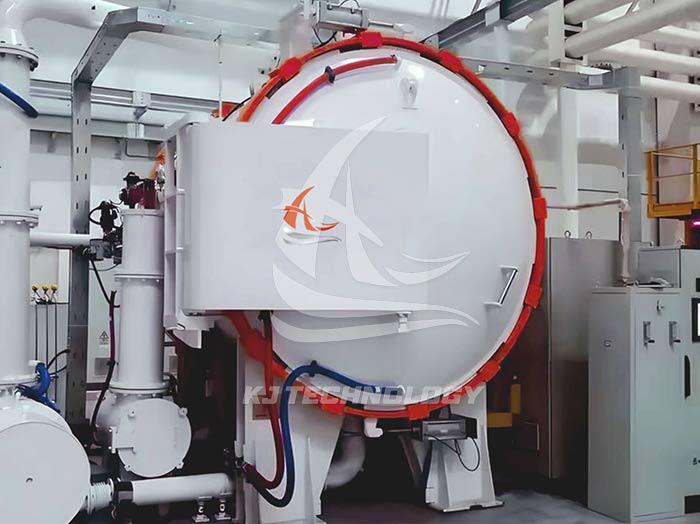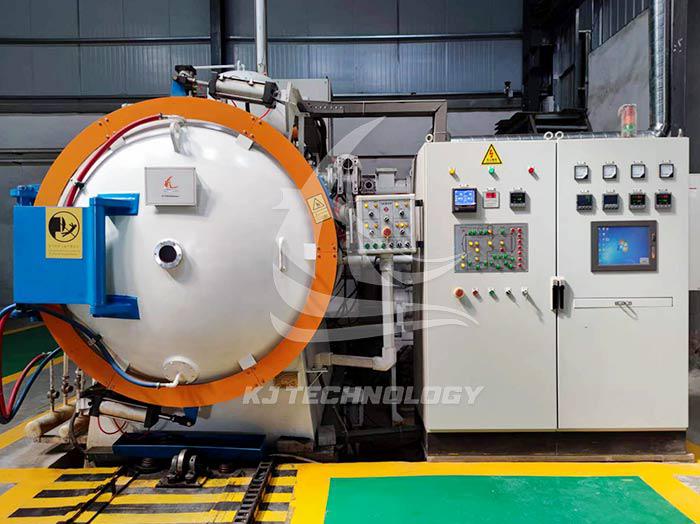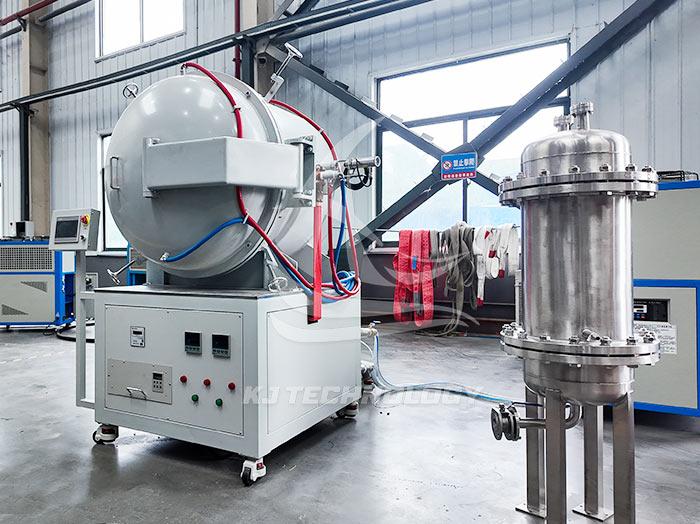What should be noted when sintering in a vacuum heat treatment furnace?
 05-19-2025 Author: KJ technology
05-19-2025 Author: KJ technology
When using a vacuum heat treatment furnace for sintering, it is necessary to comprehensively consider material characteristics, equipment functions, and process parameters to ensure sintering quality and safety.
1. Material preparation and pretreatment
Powder characteristic matching
Particle size control: The powder particle size should be uniform (recommended D50=5-20 μ m) to avoid agglomeration or uneven sintering caused by coarse particles.
Case: When sintering hard alloys, if the particle size difference of WC powder is greater than 30%, pores or cracks are prone to occur.
Purity requirement: The purity of metal powder should be ≥ 99.5% to avoid impurities (such as O, S) affecting sintering activity.
Data: For every 0.1wt% increase in oxygen content in titanium alloy powder, the strength decreases by 5-8% after sintering.
Density and strength of molded body
Compaction density: The relative density of the green body should be ≥ 55% (metal powder) to avoid excessive shrinkage or deformation during sintering.
Case: When the density of stainless steel powder injection molded green body is insufficient, the sintering shrinkage rate is greater than 18%, which can easily lead to size deviation.
Degreasing treatment: Organic binders need to be completely removed under vacuum or hydrogen atmosphere (usually at a temperature of 300-600 ℃) to avoid residual carbon pollution.
Optimization of furnace loading method
Selection of supporting materials: Use high-purity graphite or alumina pads to avoid reaction with the workpiece.
Taboo: Placing titanium alloy directly on a stainless steel tray for sintering may cause Fe contamination.
Interlayer spacing: The workpiece spacing is ≥ 10mm to ensure uniform airflow and thermal radiation.
2. Equipment operation and parameter control
Vacuum degree and atmosphere management
Initial vacuuming:
After rough pumping to ≤ 10 Pa, turn on the diffusion pump to pump to the ultimate vacuum (≤ 10 ⁻³ Pa).
Risk: Heating directly to high temperatures may cause powder oxidation or gas release, leading to explosion.
Partial pressure sintering:
Sensitive materials (such as TiAl alloys) require the introduction of trace amounts of Ar (0.1-10 Pa) to control the oxygen partial pressure.
Data: When the oxygen partial pressure is greater than 10 ⁻² ⁰ Pa, an Al ₂ O3 film forms on the surface of TiAl alloy, hindering densification.
Temperature curve design
Heating rate:
Metal powder: 5-10 ℃/min (to avoid thermal stress cracking).
Ceramic material: 2-5 ℃/min (to prevent abnormal grain growth).
Insulation time:
According to the diffusion coefficient of the material, WC Co hard alloy requires insulation at 1200-1300 ℃ for 1-2 hours.
Tool: Use JMatPro software to simulate diffusion dynamics and optimize insulation time.
Cooling rate control
Metal material: Cool down in the furnace to<200 ℃ and remove from the furnace to avoid phase transition stress caused by rapid cooling.
Ceramic materials: Some require rapid cooling (such as silicon nitride), but the cooling rate should be controlled to ≤ 50 ℃/min to prevent cracking.
3. Process monitoring and quality inspection
Process parameter recording
Real time monitoring and recording of temperature, vacuum degree, and atmosphere pressure to ensure process repeatability.
Case: A certain enterprise reduced the fluctuation of sintering density from ± 0.05 g/cm ³ to ± 0.02 g/cm ³ through SPC statistical process control.
Quality inspection methods
Density test: Archimedes displacement method measures relative density (target ≥ 98%).
Metallographic analysis: SEM observation of porosity (<0.5%) and grain size (e.g. WC grain size ≤ 1 μ m in hard alloy).
Performance testing: Hardness (HV), flexural strength (MPa), and fracture toughness (MPa · m ¹/²) must comply with standards such as ASTM B962.
4. Safety protection and emergency response
Security risk identification
Dust explosion: There is a risk of explosion when the concentration of metal powders (such as Al, Mg) in the air is greater than 50g/m ³.
Measures: The operation room is equipped with an explosion-proof dust removal system and real-time monitoring of dust concentration.
High temperature burns: The surface temperature of the furnace can reach 200 ℃, and protective barriers and warning signs need to be set up.
Toxic gases: When sintering materials containing Pb and Cd, exhaust gas treatment devices (such as activated carbon adsorption+catalytic combustion) need to be installed.
Emergency plan
Power outage handling: Equipped with UPS power supply to maintain the operation of the vacuum pump for more than 30 minutes to prevent air backflow.
Leakage detection: Regularly use a helium mass spectrometer leak detector to test the sealing of the furnace body (leakage rate ≤ 1 × 10 ⁻⁸ Pa · m ³/s).
Fire response: When a fire breaks out in the furnace, immediately fill Ar to extinguish it, and it is strictly prohibited to open the furnace door directly.
5. Summary and Suggestions
Process adaptability: Select vacuum degree, atmosphere, and cooling method based on material characteristics to avoid "one size fits all" parameters.
Equipment maintenance: Regularly calibrate thermocouples and vacuum gauges, clean up carbon deposits and metal volatiles inside the furnace.
Personnel training: Operators need to pass professional assessments and be familiar with equipment emergency procedures and Material Safety Data Sheets (MSDS).
Through the above measures, the vacuum sintering yield can be significantly improved (target ≥ 95%), while reducing energy consumption and safety risks.








